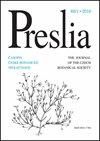捷克共和国维管植物的分布
IF 2.9
2区 生物学
Q1 PLANT SCIENCES
引用次数: 1
摘要
捷克共和国维管植物分布系列的第十二部分包括Androsace、Anthemis、Aristolochia、Berteroa、Celtis、Cnidium、Cynodon、Descurainia、Echium、erectites、Euphorbia、Homogyne、Laserpitium、Linaria、Pinus、Rosa、Sesleria、绣线菊和马鞭草属105个分类群的网格图。这些地图是由分类学专家根据检查过的植物标本、文献和实地记录制作的。既有本地物种,也有外来物种。除了广泛分布的植物如鸢尾花、鸢尾花、紫堇、大戟、梧桐树和松树外,还研究了稀有或更局部分布的植物,其中39种植物被列入国家红色名录。严重濒危物种的下降率最高,种群规模最小,种群破碎化程度最高,主要表现为Androsace septentrionalis、Echium maculatum、Euphorbia salicifolia、Laserpitium archangelica和Sesleria uliginosa。两种,Androsace maxima和Linaria arvensis,已经从这个国家灭绝;然而,前者存活在一所大学的植物园里,在那里它已经归化了。在绘制的分类群中,有13种古植物和41种新植物,其中一半以上是捷克共和国的外来物种。其中两种外来物种已成为入侵物种。油松(Pinus strobus)对生态系统有相当大的物理影响,特别是在砂岩景观中,而erectites hieraciifolius主要在森林空地中开始普遍存在,由于最近树皮甲虫的爆发,这种栖息地在景观中的范围不断扩大,促进了这种传播。另一个在最近几十年开始区域性密集传播的物种是长齿鲨。在捷克共和国发现了5种新植物。其中,大叶马兜铃(Aristolochia macrophylla)和曲松(Pinus contorta)因逃逸种植,大胡麻(Euphorbia nutans)和马鞭草(马鞭草incompta)因多种商品而非有意进口,而马鞭草(Linaria dalatica)则是通过有意播种和自发逃逸种植相结合的方式引进的。对大戟属(Euphorbia)、松属(Pinus)、蔷薇属(Rosa)、绣线菊属(Spiraea)和马鞭草属(马鞭草属)等分类学困难、种类丰富的属进行了重要的修订和调整。单个分类群的空间分布和时间动态通常在地图上显示,并由Pladias数据库中的记录记录,并在补充材料中提供。这些地图附有注释,其中包括有关该分类群的分布、栖息地、分类和生物学的额外信息。本文章由计算机程序翻译,如有差异,请以英文原文为准。
Distributions of vascular plants in the Czech Republic
The twelfth part of the series on the distributions of vascular plants in the Czech Republic includes grid maps of 105 taxa in the genera Androsace, Anthemis, Aristolochia, Berteroa, Celtis, Cnidium, Cynodon, Descurainia, Echium, Erechtites, Euphorbia, Homogyne, Laserpitium, Linaria, Pinus, Rosa, Sesleria, Spiraea and Verbena. These maps were produced by taxonomic experts based on examined herbarium specimens, literature and field records. Both native and alien species are represented. In addition to widespread plants such as Berteroa incana, Descurainia sophia, Echium vulgare, Euphorbia cyparissias, Linaria vulgaris and Pinus sylvestris, plants that are rare or have more localized distributions were also studied, with 39 of them being on the national Red List. The highest rates of decline, smallest population sizes and the highest degree of population fragmentation are found in critically threatened species, represented by Androsace septentrionalis, Echium maculatum, Euphorbia salicifolia, Laserpitium archangelica and Sesleria uliginosa. Two species, Androsace maxima and Linaria arvensis, have been extirpated from this country; however, the former survives in a university botanical garden where it has become naturalized. With 13 archaeophytes and 41 neophytes among the mapped taxa, over a half of them are alien to the Czech Republic. Two of the alien species have become invasive. Pinus strobus has considerable physical impact on ecosystems particularly in sandstone landscapes, while Erechtites hieraciifolius started to be common mainly in forest clearings, with this spread being facilitated by the increasing extent of this habitat in the landscape due to the recent bark beetle outbreak. Another species that regionally started to spread intensively during recent decades is Cynodon dactylon. Five species were identified as new neophytes for the Czech Republic. Of these, Aristolochia macrophylla and Pinus contorta escaped from cultivation, Euphorbia nutans and Verbena incompta were unintentionally imported with various commodities, whereas Linaria dalmatica was introduced through the combination of intentional sowing and spontaneous escape from cultivation. Important revisions and adjustments are provided for taxonomically difficult and species-rich genera such as Euphorbia, Pinus, Rosa, Spiraea and Verbena. Spatial distributions and often also temporal dynamics of individual taxa are shown in maps and documented by records included in the Pladias database and available in the Supplementary materials. The maps are accompanied by comments that include additional information on the distribution, habitats, taxonomy and biology of the taxa.
求助全文
通过发布文献求助,成功后即可免费获取论文全文。
去求助
来源期刊

Preslia
生物-植物科学
CiteScore
5.20
自引率
29.40%
发文量
8
审稿时长
>12 weeks
期刊介绍:
Preslia is a peer-reviewed scientific journal publishing original research papers on plant systematics, morphology, phytogeography, ecology and vegetation science, with a geographical focus on central Europe. The journal was founded in 1914 and named in honour of brothers Jan Svatopluk Presl (1791–1849) and Karel Bořivoj Presl (1794–1852), outstanding Bohemian botanists. It is published quarterly by the Czech Botanical Society.
 求助内容:
求助内容: 应助结果提醒方式:
应助结果提醒方式:


